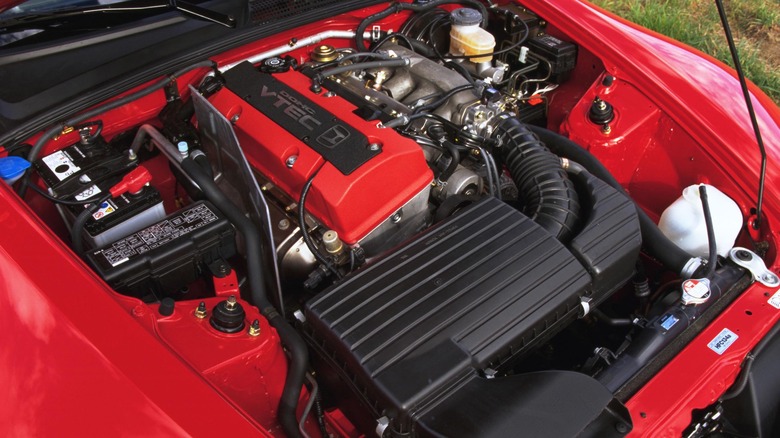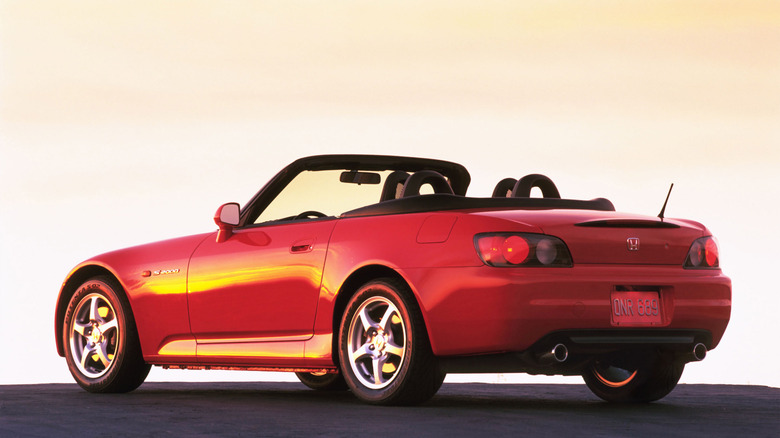Why Did Honda Discontinue The S2000?
The Honda S2000 is a brilliant example of a fun sports car, boasting a superb lightweight body (which also happens to be one of Honda's most beautiful models, at that), rear-wheel drive, and an engine that's by all accounts a miracle of engineering. Automotive reviewers, journalists, and everyone in between have sung its praises since its release back in 1999, and the car enjoyed a full ten-year tenure in showrooms, only leaving the catalog in 2009. But if it was really such a beloved car, then why was it discontinued while other Hondas like the Civic lived on? Moreover, why hasn't Honda released a spiritual successor?
In truth, there is a bit of rose-tinted glasses-style reminiscing here; the S2000 is a reminder of a time when all one needed was an open-top, no-frills sports car with a stick shift, RWD, and two seats. Honda perfected that formula, but the S2000 was a very niche car, and one that sold poorly in its final years. This wasn't a Civic that could hold a small family and some groceries in the back; instead, it was a purpose-built sports car, in the same vein as the Mazda MX-5, but with an initial price of about $30,000. Of course, the fact that S2000 prices haven't depreciated much shows us that we've learned to appreciate what we lost. But why did we lose it in the first place, and will it ever come back? Let's take a look under the hood.
Why the S2000 was so special
At its debut, Honda touted the S2000 as the equivalent of a roadgoing Formula One car with two seats. The idea was simple: construct a vehicle which emphasized the connection between car, driver, and road, to the exclusion of almost everything else. It was introduced in 1999 for the 2000 model year as a commemorative, limited-edition vehicle to celebrate Honda's 50th anniversary; to this end, the car incorporated all the lessons learned from the company's decades' worth of racing expertise and packaged it all into a svelte 2-seat roadster.
All that expertise coalesced in a truly wondrous engine, a 2.0-liter four-cylinder that revved to an astonishing 9,000 rpm, with a peak horsepower of 240 at 8,300 rpm. This resulted in an astonishing 120 horsepower per liter, which, coupled with the lightweight body, resulted in a car with a power-to-weight ratio on par with a Dodge Viper RT/10. The S2000's engine boasted the highest specific power of any naturally-aspirated four-cylinder in the world when it debuted; even today, the S2000's F20C engine is considered one of the best engines Honda ever created.
Remarkably little changed about this car throughout its tenure, save for a single facelift in 2004 and the introduction of the special-edition S2000 CR, or "Club Racer" for 2008. Not that much needed changing: Honda built the S2000 with stringent emissions and safety standards in mind, and it functioned no differently than a sedan as far as environmental and safety standards were concerned. So what was the problem?
If it's so good, then why cancel it?
Sadly, while we'd have loved to see the S2000 continue well into the modern age, the fact is that interest in the car dwindled in later years, represented by collapsing sales figures. Ultimately, while no hard figures for U.S. sales exist, fans believe that only a few hundred examples left the showroom floor in 2009, accounting for a minuscule percentage of the roughly 110,000 sold over the S2000's lifetime across all markets. Honda intended this as a niche, limited-edition car, built for a specific audience to celebrate its 50th anniversary. As such, Honda probably wasn't prepared to offer the vehicle as a long-term model and didn't make any follow-up plans.
Does that mean that the S2000 will never return? Well, never say never, but we're not holding our breath. This car was built to a standard that's 25 years old now, and Honda can't simply remake the S2000 as it was, nor would it likely have much incentive to replicate it in a new platform. The original S2000 wasn't meant as a moneymaker, after all, but more as a publicity tool, and it accomplished that perfectly. This is evident in the car's resale value alone; average prices for used S2000s are around the same as its original MSRP. It's rare for any vehicle, much less one that's 25 years old, to hold its value so consistently well, and to represent its parent company so positively. Unfortunately, despite hoaxes like the supposed 2026 Honda S2000, Honda hasn't offered anything to suggest a reboot.


